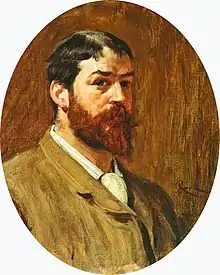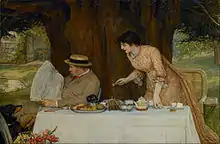Robert Walker Macbeth
Robert Walker Macbeth RA (30 September 1848 in Glasgow – 1 November 1910 in London) was a Scottish painter, etcher and watercolourist, specialising in pastoral landscape and the rustic genre. His father was the portrait painter Norman Macbeth and his niece Ann Macbeth. Two of his five brothers, James Macbeth (1847–1891) and Henry Macbeth, later Macbeth-Raeburn RA (1860–1947), were also artists.


Life

Macbeth studied in London, producing realistic everyday scenes and working for The Graphic magazine. He painted in the Lincolnshire and Somerset countryside, in works influenced by those of George Heming Mason and Frederick Walker. His The Cast Shoe was bought by the Chantrey Bequest in 1890, and is now at Tate Britain.
In 1895 he painted a mural Opening of the Royal Exchange by Her Majesty Queen Victoria, 28th October 1844 which can be seen in the Royal Exchange, London.
From 1871 Macbeth exhibited at the Royal Academy, Royal Society of Portrait Painters, Grosvenor Gallery, New Gallery and the Fine Art Society in London. There were also exhibitions in the regions at the Royal Birmingham Society of Artists in Birmingham, the Royal Scottish Academy in Edinburgh, the Royal Glasgow Institute of the Fine Arts, the Walker Art Gallery in Liverpool and Manchester Art Gallery.
In the same year (1871) Macbeth was made an associate of the Royal Watercolour Society (RWS) becoming a full member in 1901. He became a member of the Royal Society of Painter-Etchers and Engravers (RE) in 1880,[1] and an honorary member in 1909. In 1882 he was elected a member of the Royal Institute of Painters in Water Colours (RI) and in 1883 was elected to be a member of the Royal Institute of Oil Painters (ROI). In 1883 he was elected an associate of the Royal Academy (RA), becoming a full member in 1903.
He married Lydia Esther Bates on 9 August 1887 with whom he had a daughter, Phillis Macbeth, better known as the actress Lydia Bilbrook. However, it has been suggested that she was actually the biological daughter of the actor Herbert Beerbohm Tree.[2] He died in Golders Green, north London.
References
- "MACBETH, Robert Walker". Who's Who. 59: 1103. 1907.
- "National Portrait Gallery – Portrait – NPG x83016; Lydia Bilbrooke (née Phillis Macbeth)". npg.org.uk.
Bibliography
- J. L. Caw, Scottish Painting 1620–1908 (Edinburgh; London: T.C. & E.C. Jack, 1908).
- Christopher Wood, The Dictionary of Victorian Painters, Woodbridge, 1971
- Johnson, J., and Anna Gruetzner Robins, The Dictionary of British Artists 1880–1940 (Woodbridge, 1980)
- Giles Walkley, Artists' houses in London 1764–1914 (Aldershot, 1994).
- Donato Esposito, 'Robert Walker Macbeth (1848–1910)’, in Frederick Walker and the Idyllists (London: Lund Humphries, 2017), pp. 137–57.
External links
| Wikisource has the text of a 1922 Encyclopædia Britannica article about "Robert Walker Macbeth". |
| Wikimedia Commons has media related to Robert Walker Macbeth. |